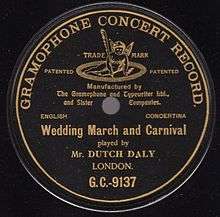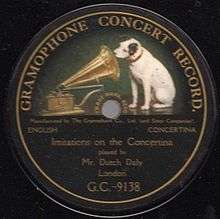Gramophone Company
The Gramophone Company Limited (The Gramophone Co. Ltd.), based in the United Kingdom and founded on behalf of Emil Berliner, was one of the early recording companies, the parent organisation for the His Master's Voice (HMV) label, and the European affiliate of the American Victor Talking Machine Company. Although the company merged with the Columbia Graphophone Company in 1931 to form Electric and Musical Industries Limited (EMI), its name "The Gramophone Company Limited" continued in the UK into the 1970s.
| Predecessor | American Record Company Carl Lindström Company |
|---|---|
| Successor | Electric and Musical Industries (EMI) |
| Founded | April 1898 |
| Defunct | 31 March 1931 |
| Headquarters | United Kingdom |
History

First recordings
The Gramophone Company was founded in April 1898 by William Barry Owen and Edmund Trevor Lloyd Wynne Williams in London, England.[1] Owen was acting as agent for Emile Berliner, inventor of the gramophone record, whilst Williams provided the finances. Most of the company's early discs were made in Hanover, Germany at a plant operated by members of Berliner's family, though it had operations around the world.[2]
In 1898, Fred Gaisberg moved from the U.S. to London to set up the first disc recording studio in Europe; it was situated in Maiden Lane. Among early artists he recorded was Syria Lamont, an Australian soprano whose single "Coming through the Rye" was one of the first ever issued. In December 1900, Owen gained the manufacturing rights for the Lambert Typewriter Company, and the Gramophone Company was for a few years renamed the Gramophone & Typewriter Ltd. This was an attempt to diversify the business model, in response to a series of lawsuits by Edison Bell.[3]
Lawsuit impact
In 1900, the U.S. parent of Gramophone lost a patent infringement suit brought on by Columbia Records and Zonophone, and was no longer permitted to produce records in the U.S. Its hardware manufacturer, Eldridge R. Johnson, of the Consolidated Talking Machine Company, left with a large factory and thousands of Gramophones with no records to play on them, filed suit that year to be permitted to make records himself, and won, in spite of the negative verdict against Berliner. This victory by Johnson, which may have been used in naming his reorganized record company the Victor Talking Machine Company the following year, may have been due in part to a patent-pooling handshake agreement with Columbia. The agreement allowed Columbia to produce disc records themselves, which they began doing in 1901; Columbia had previously been manufacturing cylinder records.
Contrary to the belief by some (especially in England), the Victor Talking Machine Company was never a branch or subsidiary of the Gramophone Company, as Johnson's factory, which had been making talking machines for Berliner, was his own enterprise with many patents that he owned, and were valuable in the agreement with Columbia.
Thus, Victor and Columbia began making disc records in the United States, with the UK Gramophone Company and others continuing to do so outside of the US. This left Edison the only major company manufacturing cylinders; Columbia continued to market cylinders in diminishing numbers until 1912. Emile Berliner established Berliner Gramophone in Montreal, where he became Victor's Canadian distributor and held the rights in Canada to the "His Master's Voice" trademark. Edison would eventually join the flat record market with his diamond discs and their players.
Hidden discs
A public relations effort of 1907 involved Alfred Clark, a New York representative of the company. Clark persuaded the Paris Opera to seal and lock 24 records in two iron and lead containers in a basement storage room. These were to be opened in 100 years. In 1912, 24 more records were added in two additional containers, along with a wind-up gramophone and a supply of needles to ensure the records could be played when unsealed.
In 1989, it was discovered that one of the 1912 containers had been opened and emptied and the gramophone stolen. The three remaining containers were moved to the French National Library. When opened in December 2007, some of the records were broken, but copies of the missing and broken records were located in the French National Library. EMI digitized the collection and released it on three compact discs in February 2009 as Les Urnes de l'Opera.

Logo change
In February 1909, the company introduced new labels featuring the famous trademark known as "His Master's Voice", generally referred to as HMV, to distinguish them from earlier labels which featured an outline of the Recording Angel trademark. The latter had been designed by Theodore Birnbaum, an executive of the Gramophone Company pressing plant in Hanover, Germany. While the general public came to refer to the records and company as "His Master's Voice" or "HMV" because of the prominence of the phrase on the record labels, The Gramophone Company was never officially known as the HMV or His Master's Voice Company. The painting "His Master's Voice" was made in the 1890s with the dog Nipper listening to an Edison cylinder phonograph. In 1899, Owen bought the painting from Francis Barraud, the artist, and asked him to paint out the Edison machine and substitute a Gramophone, which he did. In 1900, Emile Berliner acquired the US rights to the painting and it became the trademark of the Victor Talking Machine Company in 1901. UK rights to the logo were reserved by Gramophone. Nipper the dog lived from 1884 to 1895 and is honoured in England with a celebrated grave marker.
Formation of EMI
In March 1931, Gramophone merged with the English Columbia Graphophone Company to form Electric and Musical Industries Ltd (EMI). The "Gramophone Company, Ltd." name, however, continued to be used for many decades, especially for copyright notices on records. Gramophone Company of India was formed in 1946. The Gramophone Company Ltd legal entity was renamed EMI Records Ltd. in 1973.
Acoustic Recordings
From the 1890s to mid-1925, recordings were made without any electrical equipment, relying instead upon the energy inherent in the sound waves generated by the performers, to activate the recording apparatus.
See also
- List of record labels
- EMI
- His Master's Voice
- List of phonograph manufacturers
- Angel Records
- Nipper the dog, and logo variations
- Addis v Gramophone Co Ltd [1909] UKHL 1
References
- *Death of Gramophone Pioneer: Mr. Trevor Williams Iver Heath; Uxbridge & W. Drayton Gazette December 13, 1946
- Rye, Howard (2002). Kernfeld, Barry (ed.). The New Grove Dictionary of Jazz. 2 (2nd ed.). New York: Grove's Dictionaries. p. 80. ISBN 1-56159-284-6.
- Read, Oliver; Welch, Walter L. (1976). From Tinfoil to Stereo (2 ed.). Indianapolis, Indiana: Howard W. Sams & Co. p. 143. ISBN 0-672-21206-4.
- Death of Gramophone Pioneer: Uxbridge & W. Drayton Gazette December 13, 1946
- John R. Bennett: A catalogue of vocal recordings from the English catalogues of the Gramophone Company 1898–1899, the Gramophone Company Limited 1899 - 1900, the Gramophone & Typewriter Company Limited 1901–1907 and the Gramophone Company Limited 1907 – 1925. England,Oakwood Press, 1956. Available at archive.org.(reprint: Westport, Conn.,USA, Greenwood Press, 1978. ISBN 0-313-20237-0)
- Alan Kelly: His master's voice – La voce del padrone|the Italian catalogue; a complete numerical catalogue of Italian gramophone recordings made from 1898 to 1929 in Italy and elsewhere by the Gramophone Company Ltd.. New York; NY [et al.], Greenwood Press, 1988. ISBN 0-313-26498-8
- Alan Kelly: His master's voice, the French catalogue; a complete numerical catalogue of French gramophone recordings made from 1898 to 1929 in France and elsewhere by the Gramophone Company Ltd. New York; NY [et al.], Greenwood Press, 1990. ISBN 0-313-27333-2
- Alan Kelly: His master's voice, the German catalogue; a complete numerical catalogue of German gramophone recordings made from 1898 to 1929 in Germany, Austria, and elsewhere by The Gramophone Company Ltd. New York; NY [et al.], Greenwood Press, 1994. ISBN 0-313-29220-5
- Alan Kelly; Jacques Klöters: His master's voice, the Dutch catalogue; a complete numerical catalogue of Dutch and Belgian gramophone recordings made from 1900 to 1929 in Holland, Belgium, and elsewhere by the Gramophone Company Ltd. Westport, Conn. [et al.], Greenwood Press, 1997. ISBN 0-313-29883-1
- The voice, the magazine of the Gramophone Co., Ltd., Hayes, Middlesex, 1.1917 - 35.1954